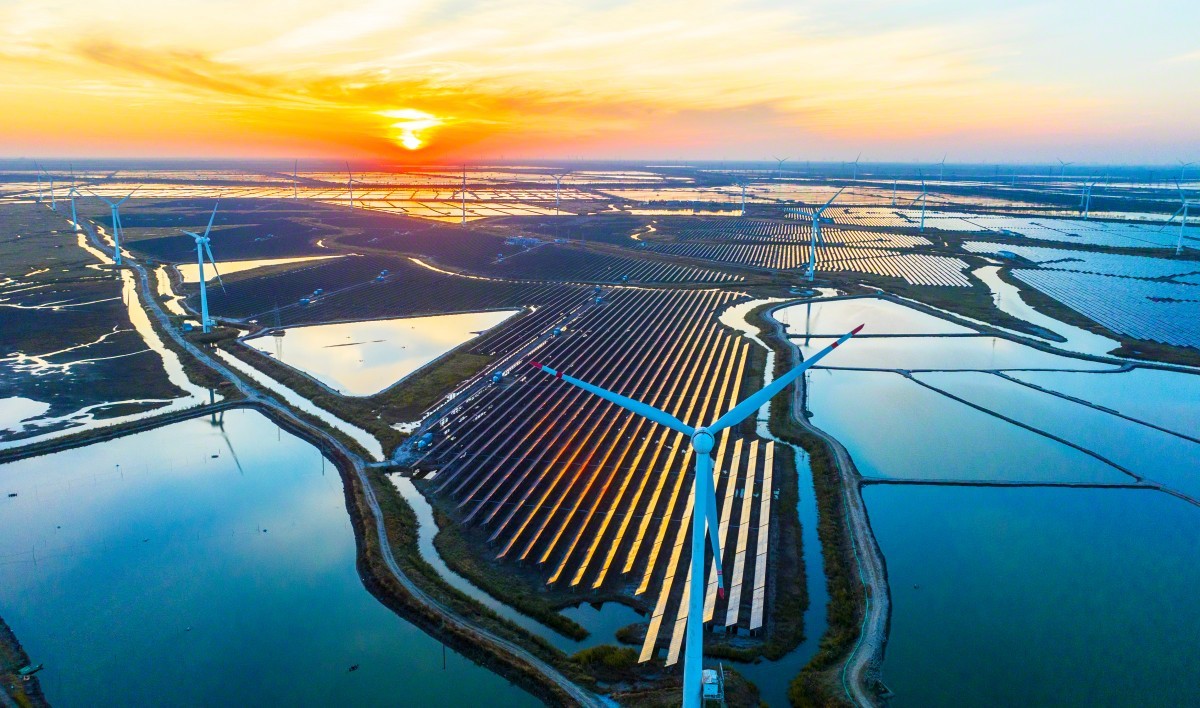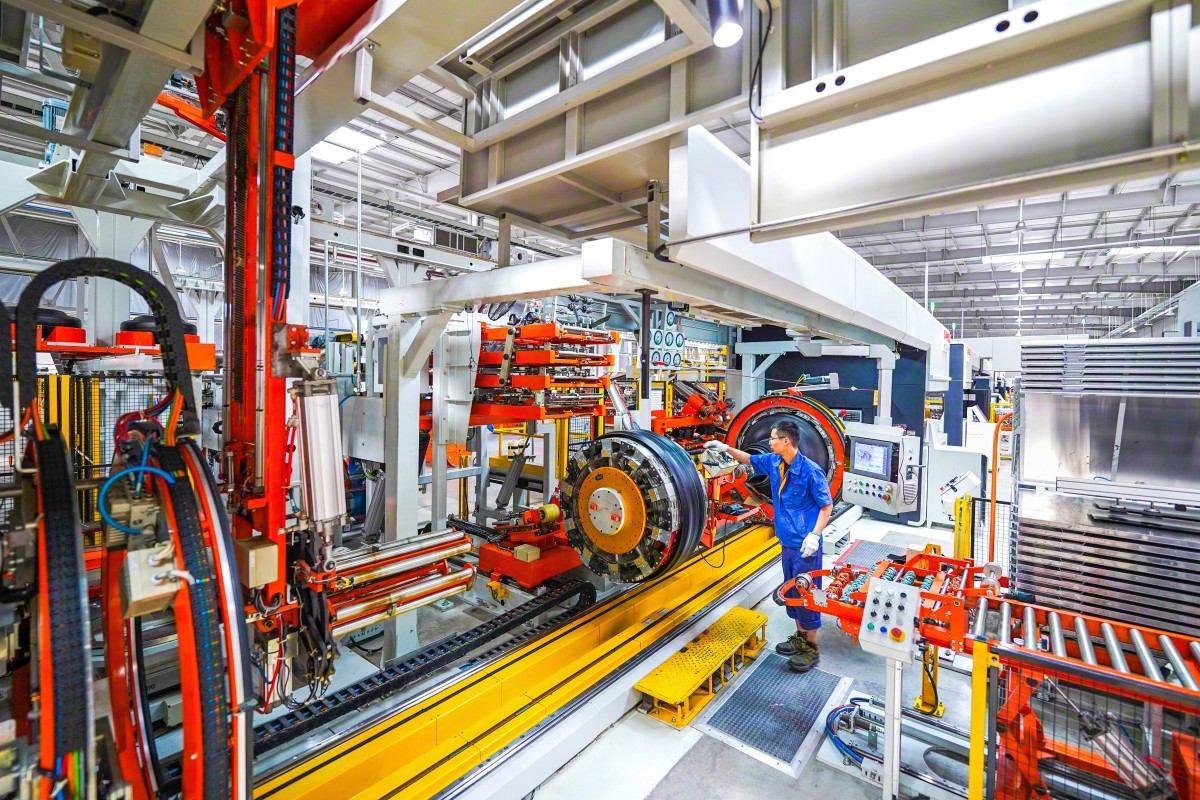In 2024, Jiangsu made greater efforts to deeply integrate scientific and technological innovation with industrial innovation, and accelerated steps to build Jiangsu into an industrial technology innovation center with global influence and an advanced manufacturing base with global competitiveness and create an important platform for developing new quality productive forces, striving to pioneer and shoulder greater responsibilities in China’s endeavor to become a science, technology and manufacturing powerhouse.
Industrial Development
In 2024, the added value of Jiangsu’s industrial enterprises above the designated size increased by 7.6%, with the growth rate ranking among the top of China’s major provincial economies. The high-quality development index of the manufacturing industry hit 89.0, ranking first nationwide for four consecutive years. The level of integration of industrialization and digital transformation reached 69.2, ranking first in the country for 10 consecutive years. The output value of high-tech industries accounted for over 50% of that of industries above the designated size for the first time. The output value of strategic emerging industries accounted for 41.8% of that of industries above the designated size.
Development of the modern industrial system accelerated. Efforts were made to develop the “1650” industrial system (namely, 16 advanced manufacturing clusters and 50 key industrial chains which Jiangsu pledged to develop during the 14th Five-Year Plan period) and the “51010” strategic emerging industrial clusters (namely, five globally competitive strategic emerging industrial clusters, 10 nationally leading strategic emerging industrial clusters and 10 ground-breaking future industrial clusters). The province boasted 14 national-level advanced manufacturing clusters distributed in all its 13 prefecture-level cities, which was the largest number among all the provinces and autonomous regions in the country. The enterprise cultivation and support initiative was implemented to strengthen the industrial chain, fostering new quality productive forces through the contributions of high-quality science and technology innovation enterprises. Jiangsu’s industries like engineering machinery, high-end textiles, and photovoltaics emerged as global front-runners, and power batteries, marine engineering equipment, new power equipment, and new energy vehicles achieved national leadership. The province implemented a three-year action plan to accelerate the cultivation and development of future industries, and conducted pilot projects for the development of future industry clusters. Focusing on cutting-edge future industries such as quantum technology, deep-sea, deep-earth, aerospace and aviation explorations, and humanoid robots, a full life-cycle cultivation system encompassing technology sourcing, application-driven innovation, enterprise incubation and industrial clustering was set up.
Industrial innovation capabilities were enhanced. The development of innovation platforms was bolstered, with support provided to three national-level manufacturing innovation centers in making breakthroughs in key technologies and ending foreign monopolies. Seven national-level and 740 provincial-level enterprise technology centers were newly added. Leading enterprises were supported in playing a leading role to integrate upstream and downstream innovation resources along the industrial chain for collaborative research, and the promotion, application and transformation of innovative achievements was strengthened.
Industrial transformation and upgrading was accelerated. The province implemented the rejuvenation program for traditional industries. Five major initiatives to eliminate outdated practices, upgrade old facilities, pursue green transformation, enhance product quality, and improve industrial layout were implemented concurrently. Continuous progress was made in updating and upgrading old installations in chemical (hazardous chemicals) enterprises. The province carried out large-scale equipment renewal and technological transformation across industrial sectors. Intelligent transformation, digital transition, and network connectivity were expanded. The three-year action plan (2022-2024) for intelligent transformation and digital transition of the manufacturing industry was completed, with over 60,000 companies assessed and more than 56,000 projects transformed. In 2024, 1,358 provincial-level intelligent manufacturing workshops and 207 provincial-level smart factories (including 5G-enabled factories and industrial internet benchmark factories) were newly recognized. Jiangsu ranked among the top nationwide in the numbers of newly added national leading digital enterprises, national excellence-level intelligent factories, and national 5G-enabled factories. The province made significant progress in advancing digital infrastructure construction, with 51,000 new 5G base stations built.
The green manufacturing system was improved. A list of current energy efficiency levels for key production facilities in high-energy-consuming industries was formulated to promote energy conservation, carbon reduction, and equipment upgrading in major energy-consuming enterprises. Efforts were made to organize the building of national-level green manufacturing demonstration sites, with the numbers of newly added green factories and green industrial parks ranking first nationwide.
Scientific and Technological Innovation
In 2024, Jiangsu’s regional innovation capability ranking climbed to the second place nationwide, with R&D investment reaching 3.33% of its GDP and 74.5 invention patents per 10,000 people. Its scientific and technological innovation strength shifted from quantitative accumulation to qualitative leap.
The province made continuous efforts to make major scientific and technological breakthroughs. A total of 46 key tasks under provincial major science and technology projects and 80 frontier technology R&D projects were launched. Thirteen innovative drugs were approved for marketing, ranking first nationwide. Fourteen projects under the provincial science and technology initiative for carbon peaking and carbon neutrality were implemented. Thirty-nine general projects received the 2023 National Science and Technology Award.
Basic research was planned systematically. The province established a new special fund for basic research, three provincial basic science centers in physics, applied mathematics, and synthetic biology would be built according to the plan, and 67 key basic research projects were carried out. Jiangsu undertook over 5,000 projects supported by the National Natural Science Foundation, ranking first among all the provinces and autonomous regions in China. One research achievement was selected into the Science magazine’s top 10 scientific breakthroughs in 2024, and three into China’s top 10 scientific advances in 2024.
Platform development was accelerated. Jiangsu secured approval to establish China’s first regional university technology transfer center. The province successfully hosted the 2024 China University Science and Technology Achievements Fair. The provincial government collaborated with the Chinese Academy of Sciences to establish an industrial artificial intelligence research institute. Development of the Suzhou Lab as well as Purple Mountain Laboratories, Taihu Laboratory, and other national strategic technological innovation institutions was accelerated. Jiangsu was approved to lead the development of 44 national key laboratories. The number of members in the Jiangsu Provincial Laboratory Alliance increased to 60. Two sub-centers of a national-level technological innovation center and one engineering integrated innovation center were newly approved.
Enterprises’ innovation capabilities were significantly improved. Policies such as the 15 measures to promote high-quality development of high-tech enterprises and the 11 support initiatives to cultivate unicorn enterprises and foster new quality productive forces were issued. The province accommodated over 57,000 high-tech enterprises, 89,000 science and technology SMEs, and 111 companies listed on the STAR Market. About 13.3% of China’s unicorn companies and 23.1% of its potential unicorn companies came from Jiangsu.
Open and collaborative innovation was further expanded. National key laboratories and leading (chain leader) enterprises were encouraged to set up an in-house “1+1+X” joint mechanism. The province took the lead in setting up the first batch of 12 Yangtze River Delta (YRD) innovation consortia, and bolstered the connectivity of YRD hub “1+4” computing power platforms at a faster pace (“1” refers to YRD Shanghai computing power connectivity platform; “4” refers to Shanghai computing power trading platform, Suzhou public computing power service platform, Alibaba YRD (Jiashan) smart computing base, and YRD hub Wuhu cluster computing power public service platform) to facilitate the efforts to balance allocation of computing power between eastern and western regions in China. We put in place 154 new systems and mechanisms in the demonstration zone of integrated development in cumulative terms. Sunan National Innovation Park undertook seven pilot tasks under the national policy of selecting persons-in-charge among competing candidates for tackling difficulties of key projects, which was the second largest number nationwide. Shanghai-Suzhou ranked fifth and Nanjing ninth in the global top 100 innovation clusters list.

